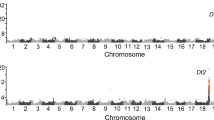Summary
Provided the nature of inheritance is known, the frequency of homozygous mutant plants in individual M2 families (derived from M1 seed) can be used to estimate the genetically effective cell number (GECN). Segregation ratios in M3 families derived from M2 wild-type plants indicated that the supernodulation characters nts382, nts1007 and nts183 are inherited as Mendelian recessives. The nature of inheritance was also known or confirmed to be recessive by crossing the wild type to these and several other mutants derived from the same population of M2 families. Subsequently, using the frequency of mutant plants in individual M2 families, the GECN for soybean was calculated to be approximately two.
Similar content being viewed by others
References
Anderson EG, Longley AE, Li CH, Retherford KL (1949) Hereditary effects produced in maize by radiations from the Bikini atomic bomb. 1. Studies on seedlings and pollen of the exposed generation. Genetics 34:639–646
Caldwell BE (1966) Inheritance of a strain-specific ineffective nodulation in soybeans. Crop Sci 6:427–428
Carroll BJ, Gresshoff PM (1986) Isolation and initial characterisation of constitutive nitrate reductase-deficient mutants NR328 and NR345 of soybean (Glycine max). Plant Physiol 81:572–576
Carroll BJ, McNeil DL, Gresshoff PM (1985a) Isolation and properties of soybean mutants which nodulate in the presence of high nitrate concentrations. Proc Natl Acad Sci USA 82:4162–4166
Carroll BJ, McNeil DL, Gresshoff PM (1985b) A supernodulation and nitrate tolerant symbiotic (nts) soybean mutant. Plant Physiol 78:34–40
Carroll BJ, McNeil DL, Gresshoff PM (1986) Mutagenesis of soybean [Glycine max (L.) Merr.] and the isolation of nonnodulating mutants. Plant Sci 47:109–114
Crane CF, Beversdorf WD, Bingham ET (1982) Chromosome pairing and associations at meiosis in haploid soybean (Glycine max). Can J Genet Cytol 24:293–300
Delves AC, Carroll BJ, Gresshoff PM (1988) Genetic analysis and complementation studies on a number of mutant supernodulating soybean lines. J Genet 67 (in press)
Johri MM, Coe EH Jr(1983) Clonal analysis of corn plant development. 1. The development of the tassel and the ear shoot. Dev Biol 97:154–172
Lackey JA (1981) Phaseoleae DC. In: Polhill RM, Ravens PH (eds) Advances in legume systematics. Royal Botanical Gardens, Kew, pp 301–327
Li SL, Redei GP (1969) Estimation of mutation rate in autogamous diploids. Radiat Bot 9:125–131
Mathews A (1987) Host involvement in nodule initiation in the soybean-Bradyrhizobium Symbiosis. Ph D Thesis, Department of Botany, Australian National University, Canberra
Moh CC (1961) Does a coffee plant develop from one initial cell in the shoot apex of an embryo? Rad Bot 1: 97–99
Redei GP (1975) Induction of auxotrophic mutations in plants. In: Ledoux L (ed) Genetic manipulations with plant material. Plenum Press, New York, pp 329–350
Sarma NP, Patnaik A, Jachuck PJ (1979) Azide mutagenesis in rice — effect of concentration and soaking time on induced chlorophyll mutation frequency. Environ Exp Bot 19: 117–121
Strickberger MW (1976) Genetics, 2nd edn. Macmillan New York, p 146
Vest G (1970) Rj 3 — a gene conditioning ineffective nodulation in soybean. Crop Sci 10:34–35
Vest G, Caldwell BE (1972) Rj 4 — a gene conditioning ineffective nodulation in soybean. Crop Sci 12:692–693
Williams LF, Lynch DL (1954) Inheritance of a non-nodulating character in the soybean. Agron J 46:28–29
Author information
Authors and Affiliations
Additional information
Communicated by G. Wenzel
Rights and permissions
About this article
Cite this article
Carroll, B.J., Gresshoff, P.M. & Delves, A.C. Inheritance of supernodulation in soybean and estimation of the genetically effective cell number. Theoret. Appl. Genetics 76, 54–58 (1988). https://doi.org/10.1007/BF00288831
Received:
Accepted:
Issue Date:
DOI: https://doi.org/10.1007/BF00288831




